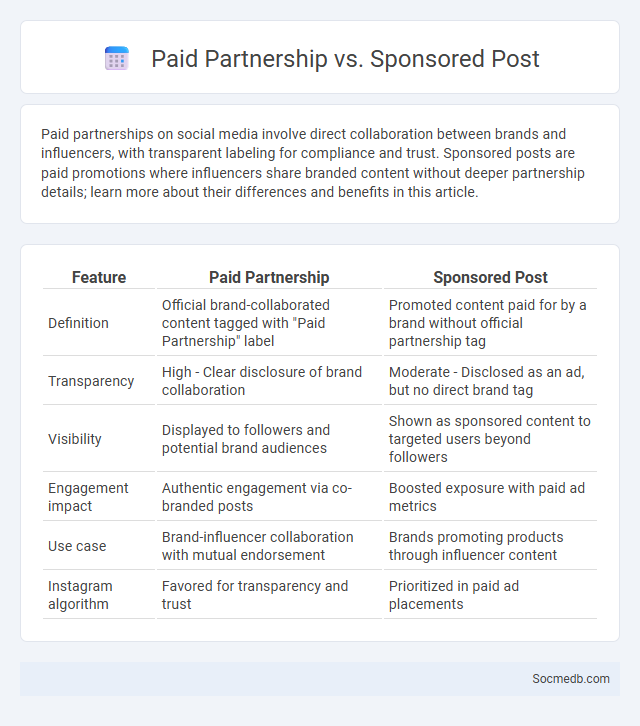
Photo illustration: Paid Partnership vs Sponsored Post
Paid partnerships on social media involve direct collaboration between brands and influencers, with transparent labeling for compliance and trust. Sponsored posts are paid promotions where influencers share branded content without deeper partnership details; learn more about their differences and benefits in this article.
Table of Comparison
| Feature | Paid Partnership | Sponsored Post |
|---|---|---|
| Definition | Official brand-collaborated content tagged with "Paid Partnership" label | Promoted content paid for by a brand without official partnership tag |
| Transparency | High - Clear disclosure of brand collaboration | Moderate - Disclosed as an ad, but no direct brand tag |
| Visibility | Displayed to followers and potential brand audiences | Shown as sponsored content to targeted users beyond followers |
| Engagement impact | Authentic engagement via co-branded posts | Boosted exposure with paid ad metrics |
| Use case | Brand-influencer collaboration with mutual endorsement | Brands promoting products through influencer content |
| Instagram algorithm | Favored for transparency and trust | Prioritized in paid ad placements |
Introduction to Paid Partnerships, Sponsored Posts, and Influencers
Paid partnerships on social media involve collaborations where brands compensate influencers or content creators to promote products or services, leveraging authentic audience engagement. Sponsored posts are specific content pieces created by influencers that explicitly feature and endorse a brand, often marked with hashtags like #ad or #sponsored for transparency. Influencers hold strategic value due to their established trust and niche follower base, driving higher conversion rates and brand awareness in targeted demographics.
Defining Paid Partnership: Meaning and Scope
Paid partnership in social media refers to a collaborative agreement where brands compensate influencers or content creators to promote products or services, clearly disclosed to maintain transparency. This arrangement spans various platforms such as Instagram, TikTok, and YouTube, enabling authentic audience engagement while driving brand visibility. The scope includes sponsored posts, product placements, and co-branded content that adheres to platform guidelines and advertising regulations.
What is a Sponsored Post? Key Features
A sponsored post is paid content on social media platforms designed to promote a brand, product, or service to a targeted audience. Key features include clear labeling as "sponsored" or "paid," precise audience targeting based on demographics and interests, and the ability to track engagement metrics such as clicks, likes, and conversions. Your brand gains increased visibility and credibility through these strategically crafted advertisements tailored to resonate with potential customers.
Who is an Influencer? Roles and Responsibilities
An influencer is a person who has established credibility and a significant following on social media platforms, leveraging their influence to shape opinions, promote products, or foster engagement within a specific niche. Their roles include creating authentic content, engaging with their audience, and collaborating with brands to drive marketing campaigns effectively. Your success in influencer marketing depends on understanding these responsibilities and how influencers connect with targeted demographics.
Major Differences Between Paid Partnerships and Sponsored Posts
Paid partnerships on social media involve a formal collaboration where both parties openly disclose the business relationship, often indicated by tags like "paid partnership" or "brand collaboration," ensuring transparency with the audience. Sponsored posts typically refer to content created or boosted by brands to promote products or services, but may not always involve full disclosure or direct involvement from the influencer in content creation. Key differences lie in legal disclosure requirements, content control, and the depth of collaboration between the influencer and brand.
Influencer Involvement: Brand Collaborations Explained
Influencer involvement plays a crucial role in social media marketing by leveraging trusted personalities to amplify brand messaging and drive engagement. Brand collaborations with influencers create authentic connections, boosting product visibility and consumer trust through relatable content tailored to target audiences. Your brand benefits from these partnerships by achieving higher reach and increased conversion rates through strategically aligned influencer endorsements.
Disclosure Requirements: Transparency and Legal Guidelines
Social media platforms enforce strict disclosure requirements to ensure transparency and compliance with legal guidelines, especially for sponsored content and influencer marketing. Your posts must clearly reveal any financial relationships or endorsements to avoid deceptive practices and adhere to regulations set by authorities like the FTC. Understanding these rules protects both your credibility and the platform's integrity.
Impact on Brand Awareness and Audience Engagement
Social media significantly enhances brand awareness by enabling companies to reach a global audience through targeted campaigns and influencer collaborations. High engagement rates on platforms like Instagram, Facebook, and Twitter foster stronger connections between brands and consumers, driving loyalty and repeat interactions. Data shows that brands active on social media experience up to 70% higher recognition compared to those relying solely on traditional marketing channels.
Choosing the Best Collaboration Type for Your Brand
Choosing the best collaboration type for your brand depends on your target audience, campaign goals, and budget. Influencer partnerships, brand ambassadorships, and content co-creation offer varied engagement levels and reach tailored to specific social media platforms. Evaluate each option's potential impact on your brand identity to maximize ROI and build authentic connections with Your followers.
Conclusion: Maximizing ROI with the Right Strategy
Maximizing ROI on social media requires a targeted strategy that aligns content with audience preferences and platform algorithms. Utilizing data analytics to refine campaigns ensures higher engagement rates and cost efficiency. Investing in consistent brand messaging and adapting to emerging trends further amplifies return on investment.
 socmedb.com
socmedb.com